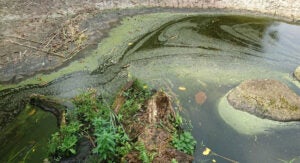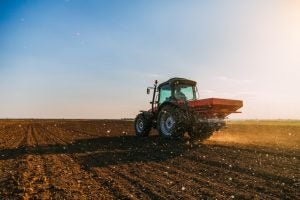When I moved into my quaint Indiana subdivision after growing up on a farm in Michigan, I was adamant that I would never pay a company to fertilize my lawn. It’s silly, I thought. A fertilized lawn just grows faster and results in additional mowings, and that would only benefit my lawn guy. Besides, my house had a fancy irrigation system for the grass, and that’s more than we ever had on the farm.
And if we’re trying to be environmentally friendly, this doesn’t seem necessary.
I survived my first summer without issue. But by the second year my lawn was half grass, half weeds. I realized I needed to do something when my neighbors started making comments and asking whether I needed a referral to a reputable fertilizer company. Heck, I’ll admit, it looked pretty bad.
So I made the call I swore I would never make. I quickly learned that the fertilizer companies don’t apply weed control without fertilizer. They also recommended at least six feedings a year. I tried to haggle for three, but it was more expensive that way. Eventually I caved and gave them a credit card. I assured myself it was fine because I was supporting a fledgling company owned by a friend of a friend.
I won’t lie, the lawn looks like a beautiful green carpet and I have a sense of satisfaction watching my dog romp around during the warm seasons.
I was reminded of my former stance — and my ultimate defeat — when I read the latest report from the National Oceanic and Atmospheric Administration about the so-called Gulf Dead Zone. Also known as the hypoxic zone, it’s an area in the Gulf of Mexico where oxygen levels are so low that marine life cannot survive.
This phenomenon occurs annually, typically in the summer, and is primarily caused by fertilizer pollution. These nutrients flow down the Mississippi River into the Gulf, leading to excessive algae growth. When the algae die and decompose, the process consumes oxygen from the water, creating hypoxic conditions. As a result, fish, shrimp, and other marine creatures either flee the area or die, leading to significant ecological and economic impacts.

The size of the Gulf Dead Zone can vary each year, but it often spans thousands of square miles. This year the dead zone is larger than anticipated and busted NOAA’s goal to reduce its overall size in five years. Efforts to reduce its size primarily focus on improving agricultural practices and reducing nutrient runoff into waterways.
But it has me wondering: Why do we always expect agriculture to lead the way and solve all the problems? Don’t get me wrong, farmers usually step up to the challenge spectacularly. Today’s family farms grow larger quantities of nutritious crops while using fewer inputs than ever before. Farmers are leaders in sustainability.
There’s no question agriculture is the largest source of nutrient runoff that contributes to the dead zone. U.S. farms used 19 million metric tons of fertilizer in 2021. Golf courses are significant fertilizer appliers too. In 2006 (the first year data was collected), U.S. golf courses used around 214,935 tons of nitrogen, potash, and phosphate. Thankfully, the number in both of those industries has gone down over the years.
But everyday homeowners applied quite a bit as well — 90 million pounds (or 8,600 metric tons). That’s certainly nothing to sneeze at. On top of it, many estimates show homeowners applying 10 times more fertilizer on lawns per acre than is applied to farmland.
And consider this. My lawn is a vanity project. It produces nothing and feeds no one. By fertilizing it, all I’m accomplishing is speeding up its growth rate so that my lawn guy has to burn more fossil fuels maintaining it. On the other hand, our farms are growing nutritious food that people need to survive. Our crops are ultimately keeping humanity alive.
Shouldn’t we try eliminating the frivolous uses before we discuss making the vital production more difficult?

Yes, our farmers could do a better job reducing fertilizer runoff from our fields. The reality is that plants can only use so much fertilizer at one time. So anyone applying anything above that rate is wasting it. And as agriculture has demonstrated, we can always find ways to be more sustainable.
Keep in mind too that the price of nitrogen, the most widely used form of fertilizer, has skyrocketed since the pandemic as a result of supply chain issues and Russia’s war on Ukraine. Few farmers want to apply more than they have to.
My point is that when we make policy and look for solutions, we should first consider the things we don’t need before we cut the things that are really, really important. It would be a lot easier and less disruptive that way.
Amanda Zaluckyj blogs under the name The Farmer’s Daughter USA. Her goal is to promote farmers and tackle the misinformation swirling around the U.S. food industry.



